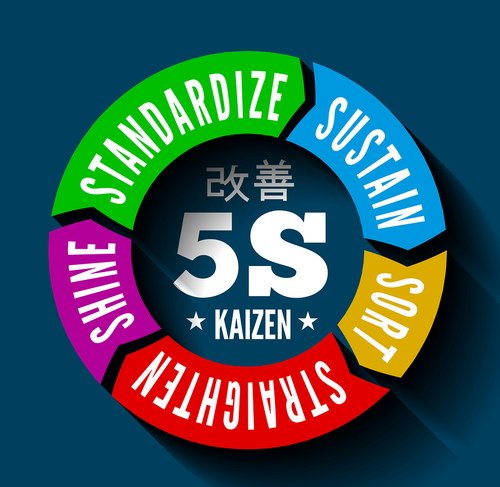Last week I had to return my car to the shop because a side mirror I replaced was not working properly. The mechanic that installed the new mirror didn’t bother to check the electronic controls. (Re-work is a profit killer!)
The front office had me drive my car into the mechanic’s work area. It would be an understatement to say it was a greasy, cluttered mess. I hesitated to get out of the car.
The friendly mechanic quickly discovered that he needed a special tool. He excused himself to go on a scavenger hunt around the shop, interrupting others to ask if they had seen it. I watched in horror (A System Thinker’s burden) as he shoved piles of stuff around in an effort to locate the tool. He finally returned ten to twelve minutes later with a big grin on his face. “I found it,” he declared.

The owner of the business would be shocked by how much money he is losing each year with eight mechanics spending time looking for tools and parts every day—not to mention re-buying items that can’t be found. With a little work, the company could permanently solve this problem and stop the serious profit leak.
Are you losing money with a dirty, cluttered, disorganized work environment? If so, keep reading.
The Japanese apply a method from “Lean” manufacturing known as 5S. The principles, however, apply to all businesses, including office-based companies. It is a set of workplace rules for keeping a business in perfect order. The 5S strategy simplifies the work environment and reduces waste and non-value activity while improving quality, efficiency, and safety.

The 5S of Lean Thinking
Consider each “S” below. (The Japanese term is in parentheses.)
1. Sort (Seiri)
Sorting involves selecting what you need to complete the job and removing everything else from your work area. This step frees up valuable workspace, removes unused tools, paper, magazines, files, cables, raw materials, scrap, and junk that has accumulated. Properly store or pitch all the stuff that is in your way.
2. Straighten (Seiton)
Arrange things in your work area in an orderly way so they are easy to find, use, and return to their proper location. Label cabinets and shelves, mark tools, outline work areas, containerize, tag, color-code, index, or whatever it takes—”a place for everything and everything in its place.” You, or anyone else, should be able to find the things you are looking for in a few seconds. This includes files on your computer.
3. Shine (Seiso)
Keep work areas, equipment, and desktops clean, maintained, and clutter-free. Eliminate messes, piles, dirt, and grime—buildup and accumulation of every kind. Incorporate cleaning into your daily routine. A clean area also makes it easier for you to spot quality problems and broken processes. When your work environment shines, so do your workers!
4. Standardize (Seiketsu)
Standardize your best practices by creating effective and written business systems and processes. Measure performance, provide feedback to workers, and involve people in the continuous improvement of your operations (Box Theory™ Gold software is a great tool for this).
5. Sustain (Shitsuke)
The most difficult step of 5S is to apply discipline and commitment to the previous four steps. Never go back to the clutter and chaos of the old way. Build habits of orderliness and cleanliness that will permanently increase job satisfaction and productivity. Expect and reward excellence.
Cleanliness is Profitable
A tidy and organized workplace pays big dividends! You will:
- Decrease waste and downtime
- Increase employee morale and pride in work
- Identify problems more quickly
- Establish efficient work practices
- Increase product and process quality
- Improve safety
- Impress customers
- Attract the best employees
- Make more money
Cleanliness and orderliness may seem of secondary importance to your business goals. However, THIS IS NOT SO!
Begin today to create a house of order—a business that shines throughout!







